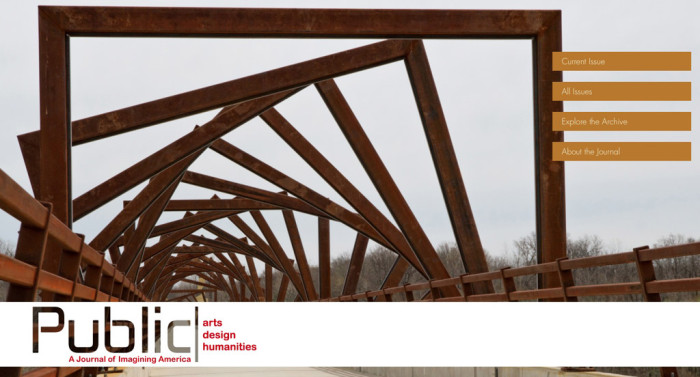Hybrid, Evolving, and Integrative Career Paths
Editorial by Jan Cohen-Cruz
In our call for this issue of Public, we asked: What alternatives to single-discipline job trajectories do public scholars and artists find and generate? What are ways of applying knowledge and skills associated with one arena to something else? In a gloomy academic job market, how are people finding satisfying positions? How can career paths evolve along with one’s interests? In response, people submitted often-poignant stories of efforts to find or expand a position, and to seek out collaborators in order to make space in their work for multiple concerns.
Germane to this theme is interdisciplinarity. While not a sine qua non of public scholarship, interdisciplinarity is a familiar trope for artists and scholars concerned with problems that no one discipline can solve. As Public editorial board member and self-described scholar, organizer, and dumpster diver Jack Tchen put it in an email to me:
Some public artists and scholars begin with single-discipline framing, and others, like me, start with a problem they are trying to solve. Through a Deweyian learning-by-doing process, I discover my capacities and limits. We do what we must to make something happen, developing new capacities ourselves.
This issue of Public encompasses contributions from diverse constituents: graduate students scanning the professional horizons, not only in search of employment at all but also for jobs that allow them to pursue their multiple passions; administrators who also teach and teachers who also envision, organize, and carry out programs; artists and scholars who have found ways to further their inquiries through positions in higher education; and others who began in higher education but who have discovered satisfying career paths outside the academy.
Here’s what you will find in this issue:
“The Future of Higher Education and Building Hybrid Careers: Reflections from Leaders in the Field,” and “Unbounded: Making Our Way to Public-Centered Work in the Arts,” both submissions by graduate students struggling in a market where PhDs are no longer presumed to lead to mono-disciplinary, tenured positions, and at the same time energized by new possibilities;
“Public Interest Design: Expanding Architecture and Design through Process and Impact,” an introduction to the breadth of possibilities subsumed in the notion of public interest design, and “Architecture as Acupuncture,” suggesting curative applications of architectural projects to the body politic. Both submissions articulate partnerships between design and architecture practitioners and people with other expertise and a move beyond the physical object as the sole aim;
An unexpected interdisciplinarity articulated in “From Nineteenth-Century Benevolence Literature to Twenty-First-Century Activism” on the part of a professor of nineteenth-century literature who has found in her work a source for contemporary activism;
Three submissions by people from related units of higher education who have sought out hybrid positions: “This Bridge Called My Job: Translating, Re-valuing, and Leveraging Intermediary Administrative Work” by administrators; “A Random Walk to Public Scholarship? Exploring Our Convergent Paths” by Museum Studies faculty; and “Three Voices: Curating Careers as Publicly Engaged Artists, Designers, and Scholars” by cohorts in art and design;
“Chronicle of a Career Suicide or My Life as a Culture Warrior,” the demise of a traditional scholarly position leading to a more satisfying professional pathway after various twists and curves;
Two reviews, one of Bridge Conversations: People Who Live and Work in Multiple Worlds, a book of exchanges between people who are themselves situated between multiple fields, and one of “Beautiful Trouble: Creative Action on the Page, in Person, and Online,” reflecting on a book, a conference, and a web initiative.
Welcome to the third issue of Public.
We are also pleased to announce the call for Volume III, Issue 2, “Local and International Public Scholarship and Creative Practice: Contrasts and Resonances.” Remember that we seek a full range of submissions, including language-driven scholarly essays, multimedia presentations, narratives, and critical reviews.
Jan Cohen-Cruz
Editor
